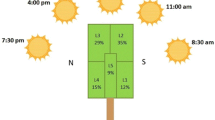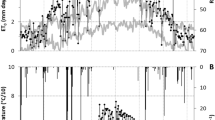Abstract
Whole-canopy gas exchange measurement in papaya can provide a scientific basis to optimize irrigation and fruit yield and quality. The objectives of this study were to: (1) verify the relationship between xylem sap flow measured by the heat coefficient method, and whole canopy transpiration in ‘Gran Golden’ papaya (Carica papaya L.), (2) examine the relationship between xylem sap flow determined from calculations based on forcing water flow through a stem section, and whole canopy transpiration, and (3) verify the relationship between transpiration measured in a plant chamber and calculated reference evapotranspiration (ET0). The experiment was conducted in a commercial planting at the Caliman Agrícola SA farm, Sooretama, ES, Brazil in summer and winter. Whole-canopy gas exchange was measured in custom-built, flow-through whole-canopy Mylar® chambers. There was a correlation (r2 = 0.65) between xylem sap flow measured with the heat coefficient (K) method and whole-canopy transpiration rate measured in the chambers. However, sap flow methodology could not convert this correlated response into an accurate estimate of papaya transpiration measured with whole canopy chambers. The sap flow methodologies were linearly correlated with whole canopy transpiration but each would require additional calibration to the crop. ET0 was correlated with whole canopy transpiration in winter but not in summer likely due to stomatal control of transpiration, as a result of the high leaf temperature and ET0 in summer. The concept of sap flow to measure transpiration has value in papaya production but supplementary studies will be necessary to improve the accuracy and estimation of the whole-canopy transpiration in the papaya plant.







Similar content being viewed by others
Abbreviations
- K:
-
Heat coefficient
- ET0 :
-
Reference evapotranspiration
- VPDleaf–air :
-
Leaf-to-air vapor pressure difference
- E:
-
Transpiration
- PAR:
-
Photosynthetically active radiation
References
Aiyelaadgbe IOQ, Falusi MOA, Babalola O (1986) Growth, development and yield of pawpaw (Carica papaya L.). ‘Homestead selection’ in response to soil moisture stress. Plant Soil 93:427–435
Allen RG, Pereira LS, Raes D, Smith M, (1998) Crop evapotranspiration: guidelines for computing crop requirements. Irrigation and drainage paper no. 56, FAO, Rome, pp 300
Baker JT, Gitz DC III, Lascano RJ (2014) Field evaluation of open system chambers for measuring whole canopy gas exchanges. Agron J 106:537–544
Bernardo S, Carvalho JA, Souza EF (1996) Papaya’s irrigation. 1st ed. Campos dos Goytacazes, Universidade Estadual do Norte Fluminense Darcy Ribeiro, UENF, technical bulletin no. 5, P 20
Campostrini E, Glenn DM (2007) Ecophysiology of papaya: a review. Braz J Plant Physiol 19:413–424
Campostrini E, Yamanishi OK (2001) Estimation of papaya leaf area using the central vein length. Sci Agricola 58:39–42
Campostrini E, Glenn DM, Yamanishi OK (2010) Papaya: environment and crop physiology. In: da Matta F (ed) Ecophysiology of tropical tree crops (agriculture issues and policies), vol 1, 1st edn. Nova Science Publishers, New York, pp 287–308
Carr MKV (2014) The water relations and irrigation requirements of papaya (Carica papaya L.). Expl Agric 50:270–283
Clemente HS, Marler TE (1996) Drought stress influences gas-exchange responses of papaya leaves to rapid changes in irradiance. J Am Soc Horicult Sci 12:292–295
Corelli GL, Magnanini E (1993) A whole-tree system for gas-exchange studies. HortScience 28:41–45
Crane JH (2005) Papaya growing in the Florida Home Landscape. University of Florida, IFAS Extension, p 8
Dhekney S (2004) Molecular investigations, cryopreservation and genetic transformation studies in papaya (Carica papaya L.) for cold hardiness. PhD Thesis, University of Florida, USA
Dragoni D, Lakso NA, Piccioni RM, Tarara JM (2006) Transpiration of grapevines in the humid northeastern United States. Am J Enol Viticult 57:460–467
Edwards WRN, Warwick NWM (1984) Transpiration from a kiwifruit vine as estimated by the heat pulse technique and the Penman–Monteith equation. N Z J Agric Res 27:537–543
El-Sharkawy MA, Cock MJH, Hernandez ADP (1985) Stomatal response to air humidity and its relation to stomatal density in a wide range of warm climate species. Photosynth Res 7:137–149
Evans EA, Ballen FH (2012) An overview of global papaya production, trade, and comsuption. University of Florida, Cooperative Extension Service Fruits Crops Fact Sheet FE913, Gainesville
FAO (2014) World reference base for soil resources. International soil classification system for naming soils and creating legends for soil maps. FAO, Roma, pp 1–181
Fernández JE, Palomo MJ, Diaz-Espejo A, Clothier BE, Green SR, Giron IF, Moreno F (2001) Heat-pulse measurements of sap flow in olives for automating irrigation: tests, root flow and diagnostics of water stress. Agric Water Manag 51:99–123
Ferraz TM (2008) Gas exchange in papaya plants on field: whole canopy versus single leaves. Dissertation, Campos dos Goytacazes, Universidade Estadual do Norte Fluminense Darcy Ribeiro, UENF, p 69
Garcia R, Norman JM, McDermitt DK (1990) Measurements of canopy gas exchange using an open chamber system. Remote Sens Rev 5:141–162
Glenn DM, Erez A, Puterka GJ, Gundrum P (2003) Particle films affect carbon assimilation and yield in ‘Empire’ apple. J Am Soc Horticult Sci 128:356–362
Granier A (1985) Une nouvelle méthode pour la mesure du flux de sève brute dans le tronc des arbres. Annal des Sci For 42:193–200
Hölttä T, Sperry J (2014) Plant water transport and cavitation. In: Mercury L et al (eds) Transport and reactivity of solutions in confined hydrosystems. Springer, Dordrecht, pp 173–181
Kempe A, Lautenschläger T, Lange A, Neinhuis C (2014) How to become a tree without wood-biomechanical analysis of the stem of Carica papaya L. Plant Biol 16:264–271
Khondaker NA, Ozawa K (2007) Papaya plant growth as affected by soil air oxygen deficiency. Acta Hort 740:225–232
Knight RJ (1980) Origin and world importance of tropical and subtropical fruit crops. In: Nagy S, Shaw PE (eds) Tropical and Subtropical Fruits: composition, properties, and uses. AVI Publishing, Westport, pp 1–120
Lakso AN, Mattii GB, Nyrop JP, Denning SS (1996) Influence of European Red Mite on leaf and whole-canopy carbon dioxide exchange, yield, fruit size, quality, and return cropping in ‘Starkrimson Delicious’ apple trees. J Am Soc Horticult Sci 121:954–958
Lassoudiere A (1968) Le papayer (Deuxieme paitie). Fruits 23:585–596
Lu P, Woo KC, Liu ZT (2002) Estimation of whole-plant transpiration of bananas using sap flow measurements. J Exp Bot 53:1771–1779
Lu P, Urban L, Zhao P (2004) Granier’s thermal dissipation probe (TDP) method for measuring sap flow in trees: theory and practice. Acta Botanica Sinica 46:631–646
Machado Filho JA, Campostrini E, Yamanishi OK, Fagundes GR (2006) Seasonal variation of leaf gas exchange in papaya plants grown under field condition. Bragantia 65:185–196
Mahouachi J, Arbona V, Gómez-Cadenas AG (2007) Hormonal changes in papaya seedlings subjected to progressive water stress and re-watering. Plant Growth Regul 53:43–51
Malo SE, Campbell CW (1986) The papaya. Univ. of Florida Cooperative Extension Service Fruits Crops Fact Sheet FC-11. Gainesville, Fla
Marler TE, Mickelbart MV (1998) Drought, leaf gas exchange, and chlorophyll fluorescence of field grown papaya. J Am Soc Horticult Sci 123:714–718
Marler TE, George AP, Nissen RJ, Andersen PC (1994) Miscellaneous tropical fruits. In: Schaffer B, Andersen PC (eds) Handbook of environmental physiology of fruits crops. V.II: Sub-tropical and tropical crops. CRC Press, Florida, pp 199–224
Miller DP, Howell GS, Flore JA (1996) A whole plant open gas exchange system for measuring net photosynthesis of potted woody plants. HortScience 31:944–946
Ogden MAH, Jackson LK, Campbell CW (1981) Florida tropical fruit culture via master gardener. Proc Fla State Hort Soc 94:222–225
Poni S, Magnanini E, Rebucci B (1997) An automated chamber system for measurements of whole vine gas exchange. HortScience 32:64–67
Poni S, Merli MC, Magnanini E, Galbignani M, Bernizzoni F, Vercesi A, Gatti M (2014) An improved multichamber gas exchange system for determining whole canopy water use efficiency in the grapevine. Am J Enol Viticult 65:268–276
Reis FO, Campostrini E (2011) Water microaspersion upon tree canopy: a study relating to gas exchange and photochemical efficiency in papaya trees 17:89–105
Reis FO, Campostrini E, Sousa EF, Silva MG (2006) Sap flow in papaya plants: laboratory calibrations and relationships with gas exchanges under field conditions. Sci Hortic 110:254–259
Rodríguez, G., B. Schafferand C. Basso. 2014. Effect of floding duration and portion of roots submerged on physiology, growth and survival of papaya (Carica papaya L.). HortScience 49:S293 (Abstract)
Samson JA (1980) Tropical fruits. Logman, London
Smith DM, Allen SJ (1996) Measurement of sap flow in plant stems. J Exp Bot 305:1833–1844
Srinivas K (1996) Plant water relations, yield, and water use of papaya (Carica papaya L.) at different evaporation-replenishment rates under drip irrigation. Trinidad. Tropical Agriculture. St. Augustine. 73:264–269
Steinberg SL, Mcfarland MJ, Worthington JW (1990) Comparison of trunk and branch sap flow with canopy transpiration in pecan. J. Exp. Botany 227:653–659
Torres Netto A (2005) Physiological characterization and water relations in papaya genotypes (Carica papaya L.). DSc thesis, Campos dos Goytacazes-RJ, Universidade Estadual do Norte Fluminense Darcy Ribeiro-UENF, 116 p
Wolf HS, Lynch SJ (1940) Papaya culture in Florida. Univ. of Fla. Agric. Exp. Sta. Bull. 350, 35 pp
Zhang H, Simmonds LP, Morison JIL, Payne D (1997) Estimation of transpiration by single trees: comparison of sap flow measurements with a combination equation. Agric For Meteorol 87:155–169
Acknowledgments
We acknowledge the support of Caliman Agrícola S/A, Financiadora de Estudos e Projetos (FINEP, Brazil), Fundação Carlos Chagas de Apoio à Pesquisa no Estado do Rio de Janeiro (FAPERJ, Brazil), National Council for Scientific and Technological Development (CNPq, Brazil) and Coordenação de Aperfeiçoamento de Pessoal de Nível Superior (CAPES, Brazil). We are also thankful to Dynamax (Houston, Texas, USA) for providing the probes to measure the xylem sap flow. We are also thankful to Dr. Bruce Schaffer, Tropical Research & Education Center (TREC), University of Florida, USA for helpful grammar corrections.
Disclaimer
Mention of a trademark, proprietary product, or vendor does not constitute a guarantee or warranty of the product by the U.S. Dept. of Agriculture and does not imply its approval to the exclusion of other products or vendors that also may be suitable. USDA is an equal opportunity provider and employer.
Author information
Authors and Affiliations
Corresponding author
Rights and permissions
About this article
Cite this article
Ferraz, T.M., Netto, A.T., De Oliveira Reis, F. et al. Relationships between sap-flow measurements, whole-canopy transpiration and reference evapotranspiration in field-grown papaya (Carica papaya L.). Theor. Exp. Plant Physiol. 27, 251–262 (2015). https://doi.org/10.1007/s40626-015-0049-z
Received:
Accepted:
Published:
Issue Date:
DOI: https://doi.org/10.1007/s40626-015-0049-z




